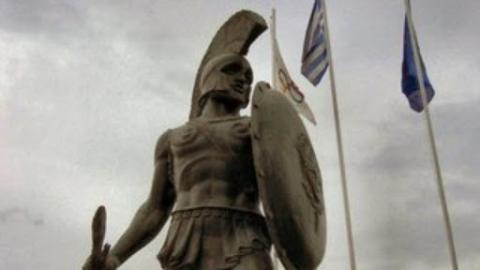The Indo-Europeans
Primary tabs

Let’s talk about the Indo-Europeans. Why is this important? Because over the last few millennia, the Indo-European peoples in both the West – in Europe – and in the East – in Iran and India – have stood in the center of all of the most significant events and processes on a planetary scale. Far from all of these events have beem graceful or wonderful, but the ups and downs of the last millennia are the work of none other than the Indo-Europeans. Today, as the fate of the Indo-European peoples and cultures is becoming all the more problematic with each passing day, and as a crisis of identity, demographic catastrophe, and overall some kind of obvious clouding of consciousness stare Indo-Europeans in the face, it is time to pose the question: who are the Indo-Europeans? What unites them, if anything unites them at all? What are they approaching in this critical moment of their history and fate?
This is also important because we, Slavs, are also part of Indo-European civilization. Our language, culture, and history are Indo-European. Moreover, the overwhelming majority of historians and linguists are convinced that the first Indo-European tribes – the ancestors of the peoples of Europe, India, Iran, and even the Malaysian Hittites – came from the lands that have been the territories of our country, Great Russia, for centuries.
The Indo-Europeans’ identity rests in the following. These are none other than the peoples who since antiquity worshipped the heavenly, fatherly gods of light. In ancient times, polytheism predominated among the Indo-Europeans, but after the birth of Christ exactly 2017 years ago, more and more Indo-Europeans, starting with the Greeks and Romans, embraced Christianity. Not all of Europe became Christian, but in this case the God of the Trinity was conceived as the uncreated Light, the Heavenly King and, after all, loyalty to light and the sky was an integral feature of the Indo-European religion.
The Indo-European peoples are of the patriarchal family. They did not humiliate women, nor did they consider them to be objects or slaves, but they did not give them free will. Indo-European patriarchy originated from the principle that the sky is the father and the earth is the mother. This does not belittle earth or women, but the vertical is obvious.
The French historian Georges Dumézil substantiated and proved that all Indo-European societies were built on a triadic model founded on three castes or estates. Priests, sacred kings, and the priesthood were the first caste. The priesthood was inseparably tied to the kingdom. The reign of an usurper, a rapist, or an idiot was considered to be an anomaly.
The second caste was that of professional warriors. The Indo-Europeans knew no equals in this regard. They could fight and always did. The Indo-Europeans domesticated the horse and invented the chariot which, of course, they used to attack, to fight, and to win. With such a spirit, the Indo-Europeans created all of the states of Europe and many of the states of Asia. In some sense, thanks to the second caste, the Indo-Europeans gradually achieved world domination. Whether this is good or bad is another question. But it is a fact that they did. It is none other than warriors who create states, and the Indo-Europeans realized this superbly.
The third caste of the Indo-Europeans consisted of peasants and laborers. Among the nomadic peoples, such as the Scythians, Sarmatians, the Jasz, the Kushan, the Saka, the Parthians, and the Vedic Aryans, this caste was made up of herdsmen. Material production, wealth, food, and women belonged mainly to the third caste, i.e., they stood at the very bottom of the Indo-European hierarchy.
The priests and king corresponded to the sky, the warriors to the air, and the peasants to the land. The Indo-Europeans’ whole system of values was founded on this, and thus it was for millennia. All types of Indo-European religions, societies, cultures, myths, tales, historical chronicles, and economic systems were built on this trifunctional, patriarchal model. This means that being an Indo-European means belonging to the society of priests, warriors, and laborers.
“But how does this relate to merchants, traders, and usurers?,” you ask. In no way. Such kinds were despised in Indo-European societies. Capitalism appeared only once Indo-European values began to be rapidly forgotten, degraded, and degenerate. Indo-European societies also did not know equality, a sign of degeneration. They did not know feminism or sodomy, by which differed the matriarchal lands and non-Indo-European cults such as the cult of Cybele.
European modernity, which abolished religion, faith in the King and the Heavenly Father, the castes, the sacred understanding of the world, and essentially patriarchy, was the beginning of the fall of Indo-European civilization. Capitalism, materialism, egalitarianism, and economism are all the revenge of those societies against which the Indo-Europeans waged war, subjugated, and strove to remedy, which composed the essence of all Indo-European peoples’ history. Modernity was the end of Indo-European civilization. It naturally corresponds to the nadir. This is not an abstraction, for it affects us in the most direct ways.
No compromises will help us. Either we will disappear and be dissolved, or we must restore our Indo-European civilization in its entirety, with all of its values, ways, and metaphysics. If we want to preserve ourselves as a people, as an Indo-European people, we must wake up and be reborn in contrast to all that has been taken for granted in the world of modernity. To hell with this world of modernity.
https://eurasianist-archive.com/2016/12/28/the-indo-europeans/
